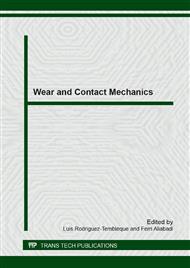p.1
p.23
p.49
p.73
p.99
p.123
p.151
p.179
On Steady Wear States for Monotonic Relative Sliding of Contacting Bodies
Abstract:
The paper presents a synthetic review of recent research carried out by the writers [1-6, 7-9] on contact shape optimization coupled with wear and on the steady wear regimes reached in the transient wear process. It was shown that these regimes can also be specified from the optimality conditions. In the analysis several classes of shape optimization problems were considered, namely minimization of wear volume rate, friction dissipation power or wear dissipation power. It was demonstrated that the contact shape evolution tends to steady or quasi-steady states satisfying the minimum principle of the wear dissipation power, resulting in the coaxiality rule requiring the wear rate vector to be collinear with the rigid body wear velocity vector. The application of steady state wear rules in specification of contact states for selected problems is discussed in the paper. The extension of method is presented for the case of multi-zone contact problems for which both transient and steady states have been analyzed.
Info:
Periodical:
Pages:
49-71
Citation:
Online since:
July 2014
Authors:
Price:
Сopyright:
© 2014 Trans Tech Publications Ltd. All Rights Reserved
Share:
Citation:


